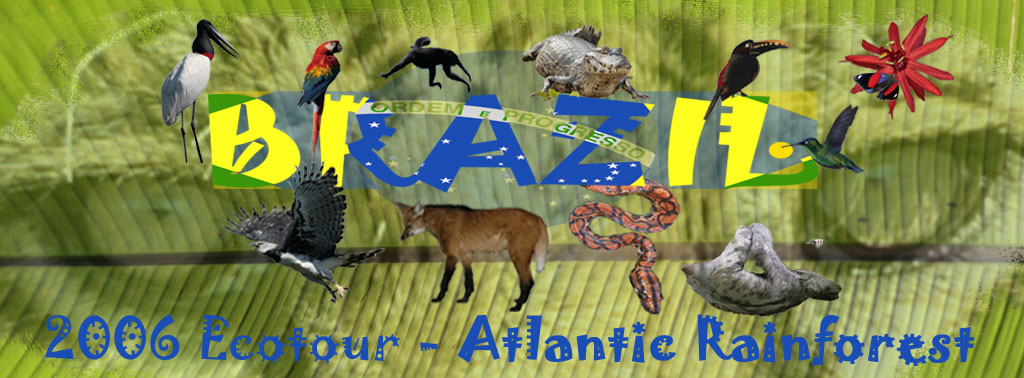



Added 3 September 2006
Day 5: Saturday, June 10, 2006
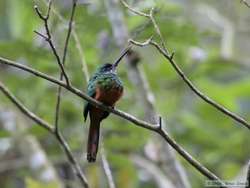
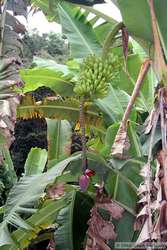
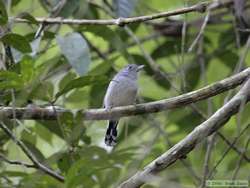 I felt a little better in the morning, but knew I was still ill, so hoped to take it easy, and figured I'd be able to relax a bit and stay off my feet, as Antonio would be driving us around in his Toyota Hilux. When we got to the Preserve though, Antonio wasn't there and nobody knew where he was. People were actually worried about him, as he is at the preserve early every single day. Fabricio decided to lead us on a little hike while we waited for Antonio, and we ended up walking quite a ways, just what I didn't want to do in my state of health.
I felt a little better in the morning, but knew I was still ill, so hoped to take it easy, and figured I'd be able to relax a bit and stay off my feet, as Antonio would be driving us around in his Toyota Hilux. When we got to the Preserve though, Antonio wasn't there and nobody knew where he was. People were actually worried about him, as he is at the preserve early every single day. Fabricio decided to lead us on a little hike while we waited for Antonio, and we ended up walking quite a ways, just what I didn't want to do in my state of health.
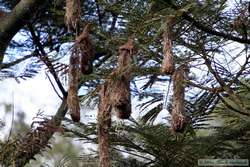 When we got back to the research station, there was still no sign of Antonio, so we decided to have an early lunch and get an early start on the long drive to Belo Horizonte. As we were driving out, here came Antonio. So we turned around, piled in to his Hilux, and zoomed off, with Dave, Shan and I in the cab and Chuck and Fabricio hanging on to the rollbar in the back. Antonio was a rather small, but very intense man. I imagine that he puts all of himself into everything that he does.
When we got back to the research station, there was still no sign of Antonio, so we decided to have an early lunch and get an early start on the long drive to Belo Horizonte. As we were driving out, here came Antonio. So we turned around, piled in to his Hilux, and zoomed off, with Dave, Shan and I in the cab and Chuck and Fabricio hanging on to the rollbar in the back. Antonio was a rather small, but very intense man. I imagine that he puts all of himself into everything that he does.
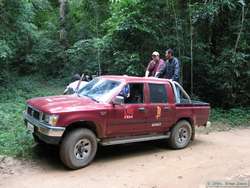 As we searched for the muriqui, he would zoom ahead a couple hundred meters and stop the engine to listen, zoom ahead another couple hundred meters and stop the engine to listen. Occasionally he would get out stride quickly away, listen intensely, and stride quickly back. One of the times he got out, instead of seeing a muriqui, he found a brown-throated three-toed sloth (Bradypus variegatus).
As we searched for the muriqui, he would zoom ahead a couple hundred meters and stop the engine to listen, zoom ahead another couple hundred meters and stop the engine to listen. Occasionally he would get out stride quickly away, listen intensely, and stride quickly back. One of the times he got out, instead of seeing a muriqui, he found a brown-throated three-toed sloth (Bradypus variegatus).
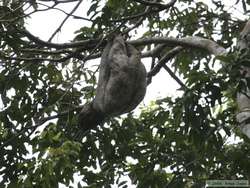 I was surprised to hear that it was the first three-toed sloth that Fabricio had ever seen, so he was really excited about seeing it. Unlike the sloths Shan and I saw in Costa Rica, this one was extremely active, at least in sloth terms. I don't think sloths have a single twitch muscle in their body.
I was surprised to hear that it was the first three-toed sloth that Fabricio had ever seen, so he was really excited about seeing it. Unlike the sloths Shan and I saw in Costa Rica, this one was extremely active, at least in sloth terms. I don't think sloths have a single twitch muscle in their body.
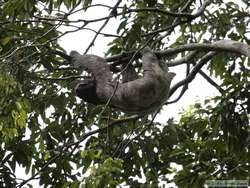 Sloths are very lethargic animals with a very low metabolism. They generally stay up in a tree for long periods of time, coming down only once every couple of weeks or so to defecate, often under the same tree. This is done to help protect them from predators. If confronted, their extremely long claws can be an effective defense, but they would prefer to remain hidden than fight. We caught this sloth in the act of switching trees, so he was moving relatively quickly down the tree, which was nice, because he gave us a variety of nice poses. It was also fascinating to me to see the sloth in motion.
Sloths are very lethargic animals with a very low metabolism. They generally stay up in a tree for long periods of time, coming down only once every couple of weeks or so to defecate, often under the same tree. This is done to help protect them from predators. If confronted, their extremely long claws can be an effective defense, but they would prefer to remain hidden than fight. We caught this sloth in the act of switching trees, so he was moving relatively quickly down the tree, which was nice, because he gave us a variety of nice poses. It was also fascinating to me to see the sloth in motion.
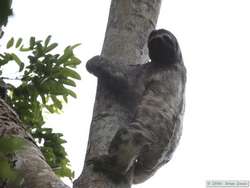 Every move appeared planned to conserve energy and each was as if in slow motion. I liken it to a slow-motion monkey. Its movement was picture of a dance, full of grace and composure. Since sloths have been known to sleep up to 20 hours a day, we were extremely lucky to see this dance.
Every move appeared planned to conserve energy and each was as if in slow motion. I liken it to a slow-motion monkey. Its movement was picture of a dance, full of grace and composure. Since sloths have been known to sleep up to 20 hours a day, we were extremely lucky to see this dance.
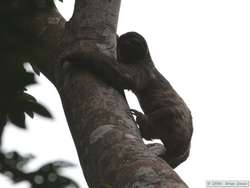
|
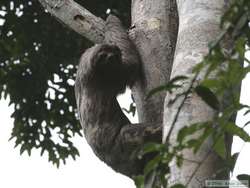
|
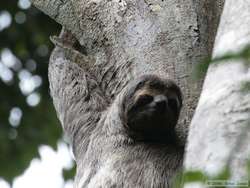
|
We stayed with the sloth for quite a while, but eventually (and reluctantly) renewed our search for the muriqui, with the understanding that we would come back to the sloth later. We drove past the point where we had hiked the previous day, and kept going quite some distance, all a couple hundred meters at a time. Eventually, we turned off of the "main" road and went through a closed gate onto a smaller four-wheel drive road. Antonio hardly slowed down on the rougher road, and Chuck and Fabricio were hanging on for dear life, occasionally having to duck under some low branches. Chuck was having the time of his life. All of the excitement boosted my adrenaline levels as well, to the point where I was temporarily feeling much better.
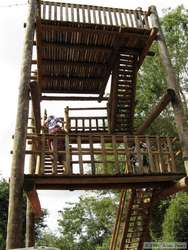
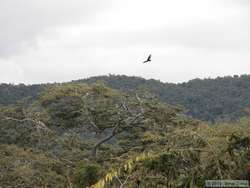
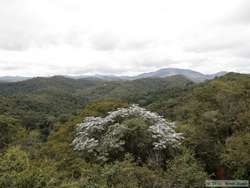 We ended up at the top of a large hill near the western property boundary of the preserve. There was a wooden observation tower there that we climbed up to scan for the muriqui. From the tower, we had an excellent vantage point to see about half of the preserve. Though quite large, it is still a very small piece of land to try to preserve the largest monkey in the Americas.
We ended up at the top of a large hill near the western property boundary of the preserve. There was a wooden observation tower there that we climbed up to scan for the muriqui. From the tower, we had an excellent vantage point to see about half of the preserve. Though quite large, it is still a very small piece of land to try to preserve the largest monkey in the Americas.
Unable to locate the muriqui from the tower, we drove back the way we came and went to the other half of the park, stopping briefly to watch the sloth in the new tree it had selected. Of course we had to take a lot more pictures while we were there . . .
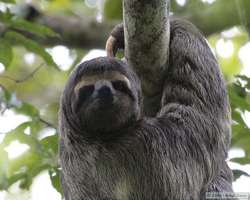
|
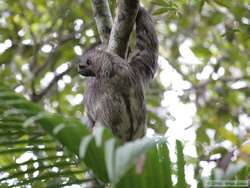
|
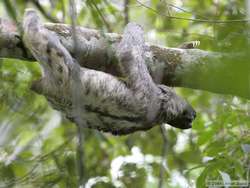
|
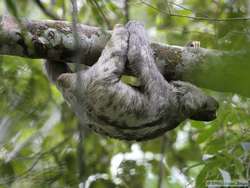
|
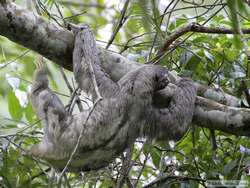
|
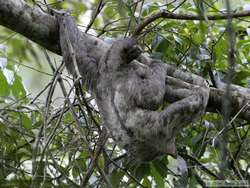
|
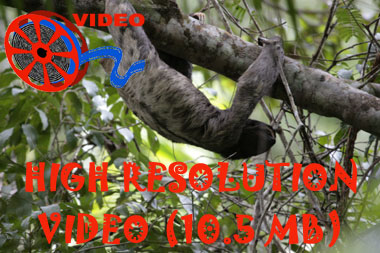
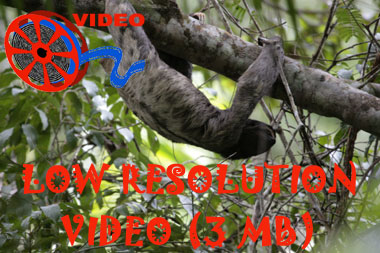 Then we zoomed off again, in no way mimicking the sloth. We ended up going through a couple more gates down a road that didn't look as though it had been driven on in some time. At the end, Antonio got out and Shan noticed a beautiful butterfly out her window. When she got out to take a picture of it, it flew away, so we both got out to try to track it down. Just as I was about to take a shot I heard Shan behind me scream, "I'm being attacked! Get them off me!" and turned to see her jumping around like she was having convulsions.
Then we zoomed off again, in no way mimicking the sloth. We ended up going through a couple more gates down a road that didn't look as though it had been driven on in some time. At the end, Antonio got out and Shan noticed a beautiful butterfly out her window. When she got out to take a picture of it, it flew away, so we both got out to try to track it down. Just as I was about to take a shot I heard Shan behind me scream, "I'm being attacked! Get them off me!" and turned to see her jumping around like she was having convulsions.
Shan has a tendency for the melodramatic response. She also often thinks that bugs are attacking her when in fact what's on her is an olive, a piece of dead skin, a hair, etc. So I have to be honest and say that my first reaction was that she was freaking out about nothing. When she started smacking at her ankles, and Dave, who was closest, started to help smack at her ankles, I thought, "Uh oh, she really did get into something." So I ran over to her and found her legs covered in ants. She had stopped to take a picture and had been standing right on top of an ant colony. It was now a very angry ant colony.
I got her seated in the truck, and we took off her boots and socks, then rolled up her pant legs as we swiped, beat, and smashed hundreds of ants off of her. A number of them had gotten quite a ways up her legs, so it took some time to get them all without having her strip her pants off. While she worked on her legs, I went through her socks and shoes and picked all of the ants off of them. Dave helped with the boots as well. Eventually we got them all, but the bites ended up being a source of discomfort and pain for her for over a week.
With that bit of excitement over, we headed back to the research station, defeated in our search for the muriqui, but happier knowing that we had at least given it a good effort. Later, in a better state of health, I became more disappointed that we hadn't seen the muriqui.
As we drove back, everyone got a good laugh out of Chuck teasing Shan for being a drama queen, and how she stepped in the ant hill because she wasn't getting enough attention.
Back at the research station, Antonio gave us some cool "Extinção é Para Sempre" (Extinction is Forever) stickers and we each bought a "Sounds of Caratinga" CD, with natural sounds of the forest, the proceeds of which go to the research station. 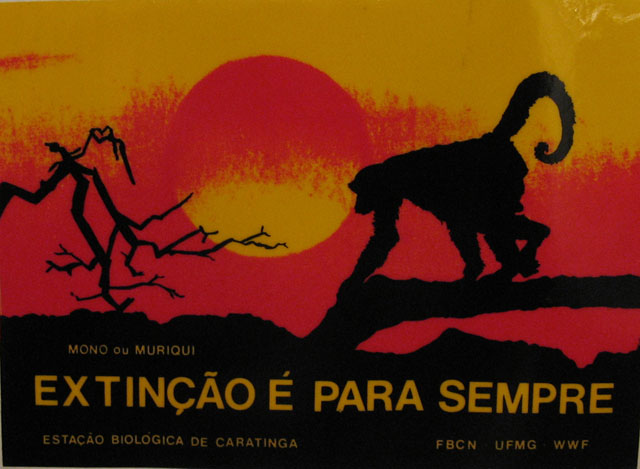 After leaving Caratinga, we had a long and arduous trek back to Belo Horizonte. We had a grueling, and sometimes harrowing six hour drive before we arrived safely at our hotel in Belo Horizonte. I was feeling really bad by that point, and once again opted to rest instead of going to dinner. This time, thinking that dinner would involve getting back in the van to go somewhere, Shan opted to skip dinner as well. They ended up eating right there in the hotel. To hear Chuck tell the tale later, it was the most sumptuous meal of them all, as the hotel was a four star hotel and had the restaurant to match. When we returned to the U.S., Chuck found an article about the muriqui by one of his colleages, published in Ecological and Environmental Anthropology entitled Human Dimensions of Northern Muriqui Conservation Efforts.
After leaving Caratinga, we had a long and arduous trek back to Belo Horizonte. We had a grueling, and sometimes harrowing six hour drive before we arrived safely at our hotel in Belo Horizonte. I was feeling really bad by that point, and once again opted to rest instead of going to dinner. This time, thinking that dinner would involve getting back in the van to go somewhere, Shan opted to skip dinner as well. They ended up eating right there in the hotel. To hear Chuck tell the tale later, it was the most sumptuous meal of them all, as the hotel was a four star hotel and had the restaurant to match. When we returned to the U.S., Chuck found an article about the muriqui by one of his colleages, published in Ecological and Environmental Anthropology entitled Human Dimensions of Northern Muriqui Conservation Efforts.
Even though I needed to re-organize gear for our flight in the morning, I opted for sleep. Before going to dinner, Chuck came over to our room to check up on me. Since Shan's hands can't be used to determine the presence of a fever since they are always cold, he confirmed that I was running a high fever but believed that to be a good sign that my body was breaking through the illness. Chuck was extremely helpful while I was sick, not only by helping me directly, but also in helping to calm Shan down, who tends to worry too much, especially where my health is involved.
Secretly (as I found out later), Chuck was extremely concerned about my state of ill health and that night discussed plans with Dave for ending the trip early and getting me back to the U.S. if I wasn't better by morning. They say that good friends are hard to find. I have to disagree. I've got a whole bunch of them. Thankfully, Chuck never had to put whatever plans he thought up into action.
Species list for the day (12 birds, 1 mammal):
Black Vulture (Coragyps atratus)
Roadside Hawk (Buteo magnirostris)
Southern Lapwing (Vanellus chilensis)
White-eyed Parakeet (Aratinga leucophthalmus)
Blue-fronted Parrot (Amazona aestiva)
Smooth-billed Ani (Crotophaga ani)
Great Potoo (Nyctibius grandis) (Shan saw this, unfortunately I did not)
Rufous-tailed Jacamar (Galbula ruficauda)
Campo Flicker (Colaptes campestris)
Variable Antshrike (Thamnophilus caerulescens)
Rufous-bellied Thrush (Turdus rufiventris)
Blue Dacnis (Dacnis cayana)
Brown-throated Three-toed Sloth (Bradypus variegates)
 |
 |